HOBO Pulse Input Adapter
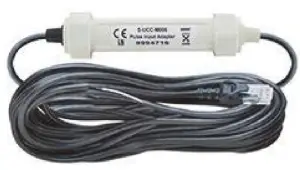
Test Equipment Depot – 800.517.8431 – 99 Washington Street Melrose, MA 02176 – TestEquipmentDepot.comThe pulse input adapters are used to log the number of switch closures per interval and are designed to work with smart sensor-compatible HOBO® loggers and stations. The adapter has a plug-in modular connector that allows it to be added easily to these devices. Two versions are available: mechanical contact closure (S-UCD-M00x) to use with tipping-bucket rain gauges (for example) and solid-state electronic switches (S-UCC-M00x) for use with compatible pulse output sensors.
Specifications
| S-UCC-M00x For Electronic Switches | S-UCC-M00x For Electronic Switches | |
| Maximum Input Frequency | 120 Hz (120 pulses per second) | 2 Hz (2 pulses per second) |
| Measurement Range | 0–65,533 pulses per logging interval | |
| Resolution | 1 pulse | |
| Lockout Time | 45 µs ±10% | 45 µs ±10% |
| Recommended Input Type | Electronic solid state switch closure or CMOS-level digital output (example: FET, opto-FET or open collector) | Mechanical contact closure (example: reed switch in a tipping-bucket rain gauge) |
| Preferred Switch State* | Active low input | Normally open |
| Edge Detection | Falling edge, Schmitt Trigger buffer (logic levels: low ≤0.6 V, high ≥2.7 V) | |
| Minimum Pulse Width | 1 ms | |
| Input/Output Impedance | 100 KΩ | |
| Open Circuit Input Voltage | 3.3 V | |
| Maximum Input Voltage | 3.6 V | |
| User Connection | 24 AWG wires, 2 leads: white(+), black(-) | |
| Operating Temperature Range | -40° to 75°C (-40° to 167°F) | |
| Overall Cable Length | 6.5 m (21.3 ft.) or 1.57 m (5.1 ft.) | |
| Length of Smart Sensor Cable** | 50 cm (1.6 ft.) | |
| Housing | Weatherproof Xenoy housing protects input adapter electronics | |
| Housing Dimensions | 12.7 x 2.9 cm (5 x 1.13 in.) | |
| Weight | S-UCx-M001: 114 g (4 oz.); S-UCx-M006: 250 g (9 oz) | |
| Bits per Sample | 16 | |
| Number of Data Channels | 1 | |
| Measurement Averaging Option | No (reports the number of pulses over the logging interval) | |
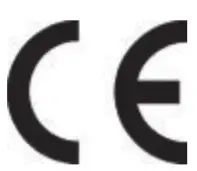 |
The CE Marking identifies this product as complying with all relevant directives in the European Union (EU). |
* For maximum battery life, the pulse input adapters should be used with their preferred switch type. The adapters will work with active high inputs (S-UCC) and normally closed switches (S-UCD), but battery life will not be optimized.** A single HOBO station can accommodate 15 data channels and up to 100 m (328 ft) of smart sensor cable (the digital communications portion of the sensor cables).
Input Connections
The Pulse Input Adapter sensor has two input connections. The white wire (+) is powered at 3.3 V through a 100 K resistor. This power is supplied from the logger’s battery. The black wire (-) is connected through the adapter to the logger’s ground connection. The input cable can be connected directly to screw terminals on the sensor or to sensor cables with the included wire nuts.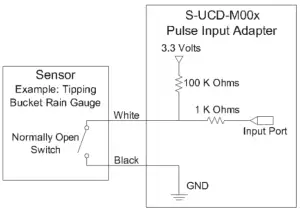
Wiring for S-UCD-M00x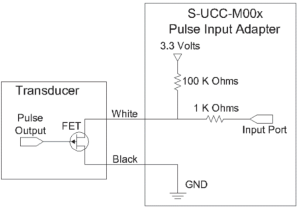 Wiring for S-UCC-M00x
Wiring for S-UCC-M00x
Connection Using Wire Nuts
| Important: If using wire nuts, make sure the connection is protected from the elements. |
- .Strip 1 cm (3/8 in.) of insulation from the end of wires, taking care not to nick the metal conductors.
- Twist the stripped wires together clockwise and then screw on the wire nut clockwise.
- Check the connection by gently pulling on the wires to verify a solid mechanical connection. Always strain-relief the connection to make sure that the connection is not broken by being jerked or repeatedly worked back and forth.
Connecting to a Logger or Station
To connect the adapter to a logger or station, stop the logger or station from logging and insert the adapter’s modular jack into an available smart sensor port on the station. See the station manual for details on operating stations with smart sensors.
Mounting
To provide long-term protection from moisture entry, the smart sensor adapter must be mounted horizontally and with the cable wires routed with drip loops so that water drains away from the cable entry point as shown in the example below. When mounted properly, the housing is weatherproof (but not waterproof).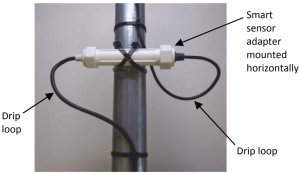
Maximizing Battery Life
The pulse input adapter consumes about 1 µA of current with the input high (switch open) and about 33 µA with the input low (switch closed). For maximum logger battery life, use the pulse input adapter with normally open switches or with transducers that are off (circuit open) for 90% of the time or longer.
Third-Party Sensors
When making a connection to a third-party sensor, take time to make sure that the connection is reliable. The connection should be protected from rain, dirt, and direct exposure to the elements. Third-party sensors purchased from Onset, such as WattNode® or Veris pulse output kWh transducers, are supplied with documentation that provides additional information for system configuration.
Verifying Functionality
To verify proper operation of the pulse input adapter, connect the adapter to a logger and launch the logger. For the S-UCDM00x model, enter a known number of pulses (for example, if using a tipping-bucket rain gauge, tip the bucket several times). Then read out the logger and verify that the number of pulses in the data file is correct.If you think either the S-UCC-M00x or S-UCD-M00x model is not capturing pulses, check the connections to the adapter and verify the device being measured is functioning normally.
Using the S-UCD-M00x Adapter (for Contact Closures)
This section describes using the S-UCD-M00x to connect the station with a mechanical contact closure.
Guidelines
- The adapter housing should be installed outside the station enclosure. Be sure to follow the instructions included with the station to ensure that the station is properly sealed where the sensor cable exits the station enclosure.
- Secure the adapter housing to the mast or sensor mounting arm. Excess cable should be coiled and secured with cable ties
- If sensor cables are left on the ground, use a conduit to protect against such things as animals, lawn mowers and exposure to chemicals.
Example: Tipping Bucket Rain Gauge or Mechanical Contact Closure
The S-UCD-M00x is designed to work with tipping-bucket rain gauges and other devices with normally open, mechanical contact closure, switched outputs with a maximum pulse frequency of 2 Hz. This sensor has a pre-set lockout time of 327 ms and is designed to work with signals that must be debounced to be accurately measured.A typical setup for connecting a sensor with a mechanical contact closure is shown below.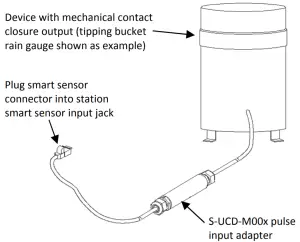
De-bouncing
“Bounce” is a phenomenon where a single pulse may contain several false pulses or bounces. De-bouncing a signal is typically required when measuring signals from mechanical switches, contact closures, and reed switches.The lockout time prevents bounce-induced false pulses from being counted as separate switch closures. If your gauge has a counter display and battery, disconnect them and connect the Pulse Input Adapter in their place. In most cases, the black and white wires can be connected directly to the relay output. (When connecting to relay or switch contacts, polarity does not matter.)
Using the S-UCC-M00x Adapter (for Electronic Switches)
This section describes using the S-UCC-M00x to connect the H22-001 or U30 Station to a device with an electronic switch.
Example: FET Switch Transducer
The 120 Hz pulse input adapter (S-UCC-M00x) is designed for devices with a normally open solid-state switch, FET switch or open collector, with a maximum pulse frequency of 120 Hz. This input adapter will not work with sensors that have mechanical switch outputs, AC outputs, or outputs that must be debounced (see previous section).A typical setup of a FET switch transducer is shown below.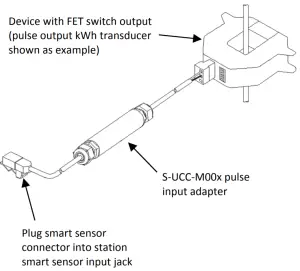
© 20102017 Onset Computer Corporation. All rights reserved. Onset and HOBO are trademarks or registered trademarks of Onset Computer Corporation. All other trademarks are the property of their respective companies.

[xyz-ips snippet=”download-snippet”]


